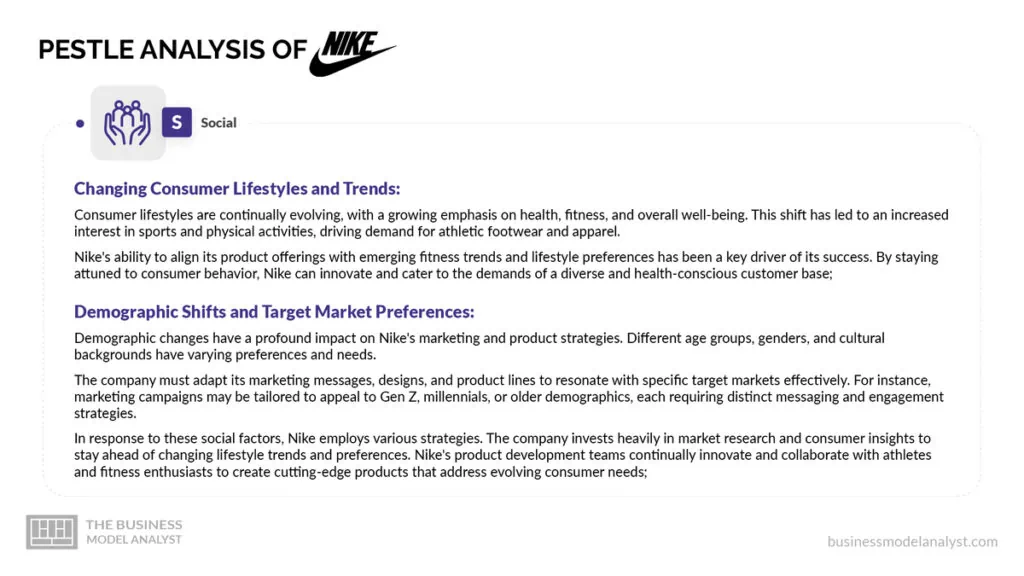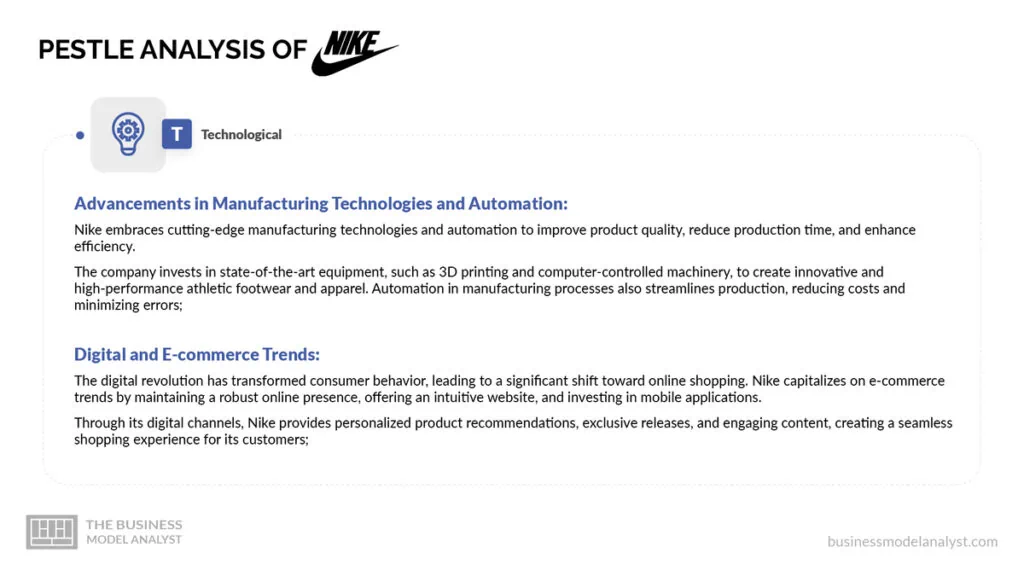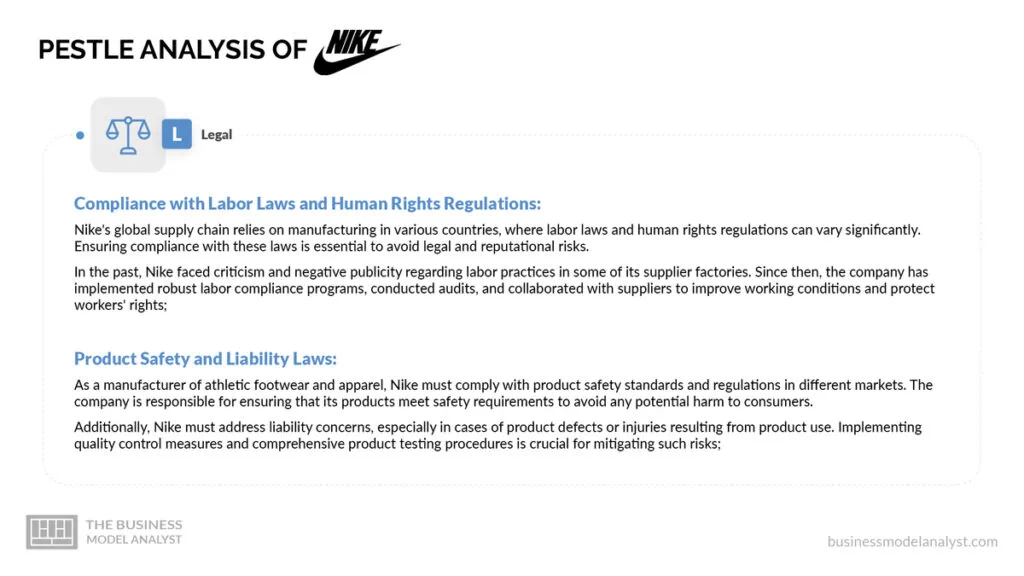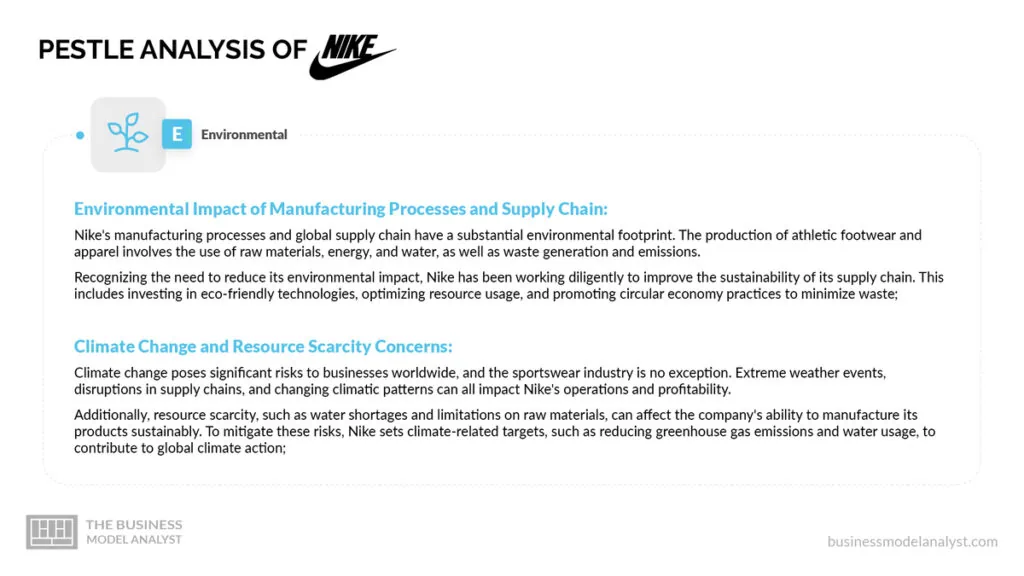Nike PESTLE Analysis: As a global leader in sportswear and athletic apparel, Nike operates in a dynamic and ever-changing business environment. From its iconic logo to its generation-defining marketing campaigns, the brand certainly needs no further introduction. However, it is vital to understand the factors underlying its astronomical success.
A PESTLE analysis is essential to gain a comprehensive understanding of the external factors influencing the company’s strategies and performance. This analysis explores the Political, Economic, Sociocultural, Technological, Legal, and Environmental aspects that impact Nike’s operations and market presence.
By examining these key factors, we can uncover valuable insights into how Nike navigates challenges and seizes opportunities in a highly competitive industry.
Contents
Nike’s Political Factors

Nike is subject to various political factors that can significantly impact its operations and performance in the international market. Understanding and effectively navigating these factors is crucial for the company’s long-term success and sustainability. Some of these factors include:
- Political Stability: Government stability and policies in key markets play a pivotal role in Nike’s global business strategy. Operating in multiple countries, the company must carefully evaluate the political climate and stability of each market it operates. Political instability or drastic policy changes in key markets could disrupt supply chains, distribution channels, and consumer demand, leading to potential losses for the company.
To mitigate the impact of political factors, Nike maintains a diversified global presence, reducing its reliance on any single market and mitigating the risks associated with political instability in specific regions. It closely monitors trade policies and tariffs, adjusting its supply chain and sourcing strategies accordingly to maintain cost-effectiveness;
- International Trade Regulations and Tariffs: Trade regulations and tariffs are critical considerations for Nike’s international operations. As a multinational corporation with complex supply chains, the imposition of tariffs or changes in trade regulations can have significant cost implications. Trade tensions between countries can also disrupt the flow of goods and increase operational expenses, affecting profitability;
- Labor Laws: Labor laws and regulations in manufacturing countries are of utmost importance to Nike due to its reliance on outsourced production. The company outsources the manufacturing of its products to various countries, especially in Asia, where labor costs are lower.
Compliance with local labor laws and ensuring fair working conditions are crucial to avoid reputational risks and potential legal issues. Any violations or negative labor practices within Nike’s supply chain can damage its brand image and lead to consumer boycotts.
Nike takes a proactive approach to complying with labor laws and regulations in manufacturing countries. The company collaborates with suppliers to improve labor conditions and implements strict auditing and monitoring mechanisms to ensure compliance throughout its supply chain;
- Copyright and Intellectual Property Protection: Another critical political factor for Nike is intellectual property protection and enforcement. As a leader in the sportswear industry, Nike invests heavily in research and development to create innovative products and designs.
Intellectual property rights protection is vital to prevent counterfeiting and unauthorized use of its designs and trademarks. Infringement issues can harm the company’s brand equity, erode customer trust, and impact its market share. Additionally, Nike vigorously defends its intellectual property rights through legal actions against counterfeiting and trademark infringement.
Political factors significantly influence Nike’s operations and market performance. By prioritizing compliance, risk management, and strategic decision-making, Nike continues to navigate the complexities of political landscapes and maintain its position as a leading sportswear brand worldwide.
Nike’s Economic Factors

Various economic factors deeply influence Nike, Inc. due to its global presence in the athletic footwear and apparel industry. These include:
- Macroeconomic Trends: The economic growth and stability of major markets have a profound impact on the company’s revenue and overall performance. During economic upswings, consumers tend to have higher disposable incomes, leading to increased spending on sportswear and fitness-related products. Conversely, in economic downturns or instability, consumer confidence may decline, resulting in reduced discretionary spending on non-essential items like athletic apparel.
Consumer income levels and purchasing power are crucial factors for Nike’s success, particularly given its premium product positioning. Higher consumer incomes generally lead to increased demand for quality and branded products, benefiting Nike as it caters to aspirational and performance-oriented segments. In emerging markets with growing middle-class populations, rising incomes create opportunities for Nike to tap into new customer bases;
- Currency Exchange Rate Fluctuations: Currency exchange rate fluctuations also play a significant role in Nike’s international sales and sourcing. When the U.S. dollar strengthens against other currencies, Nike’s foreign sales may suffer as its products become relatively more expensive in overseas markets.
Conversely, a weaker U.S. dollar can make Nike’s products more affordable for consumers abroad, potentially boosting international sales. However, currency fluctuations also impact the cost of sourcing raw materials and manufacturing products, potentially affecting profit margins;
- Interest Rates and Inflation: Interest rates and inflation rates also influence Nike’s business decisions. Interest rate changes impact the company’s borrowing cost, affecting its capital investments and expansion plans. High inflation rates can lead to increased production costs, potentially impacting consumer purchasing power and demand for Nike’s products.
Economic factors significantly influence Nike’s performance and decision-making processes. Through financial flexibility and market adaptability, Nike continues to position itself as a resilient and innovative leader in the athletic apparel industry.
Nike’s Social Factors

Social factors play a pivotal role in shaping the landscape of Nike, Inc.’s business as the company operates in a dynamic global market. Some prominent examples include:
- Changing Consumer Lifestyles and Trends: Consumer lifestyles are continually evolving, with a growing emphasis on health, fitness, and overall well-being. This shift has led to an increased interest in sports and physical activities, driving demand for athletic footwear and apparel.
Nike’s ability to align its product offerings with emerging fitness trends and lifestyle preferences has been a key driver of its success. By staying attuned to consumer behavior, Nike can innovate and cater to the demands of a diverse and health-conscious customer base;
- Demographic Shifts and Target Market Preferences: Demographic changes have a profound impact on Nike’s marketing and product strategies. Different age groups, genders, and cultural backgrounds have varying preferences and needs.
The company must adapt its marketing messages, designs, and product lines to resonate with specific target markets effectively. For instance, marketing campaigns may be tailored to appeal to Gen Z, millennials, or older demographics, each requiring distinct messaging and engagement strategies.
In response to these social factors, Nike employs various strategies. The company invests heavily in market research and consumer insights to stay ahead of changing lifestyle trends and preferences. Nike’s product development teams continually innovate and collaborate with athletes and fitness enthusiasts to create cutting-edge products that address evolving consumer needs;
- Public Attitudes towards Wellness and Sustainability: Public health concerns, such as rising obesity rates and sedentary lifestyles, have prompted increased awareness of the importance of physical activity and overall wellness. Consumers now seek products that support their well-being and align with sustainable practices.
Nike’s focus on developing performance-enhancing and comfortable athletic wear aligns with these health-conscious trends. Moreover, the company’s commitment to sustainability, such as using eco-friendly materials in its supply chain and reducing carbon footprint, resonates with environmentally conscious consumers;
- Cultural Factors Influencing Brand Perception: Nike’s global presence requires the company to be culturally sensitive and adaptive to diverse markets. Cultural factors, such as values, traditions, and norms, influence how consumers perceive and interact with brands.
Nike must carefully tailor its marketing and messaging to align with the cultural sensitivities of each region. By understanding local customs and preferences, the company can avoid potential cultural misunderstandings and ensure its brand resonates positively with consumers worldwide.
Social factors significantly impact Nike’s business strategies and brand positioning. Through continuous adaptation and consumer-centric approaches, Nike remains at the forefront of trends, connecting with consumers worldwide and solidifying its brand reputation.
Nike’s Technological Factors

Technological factors are critical influencers of Nike, Inc.’s business strategy and operations. As a leading global sportswear company, Nike harnesses technology to drive innovation, enhance customer experience, optimize supply chain efficiency, and maintain a competitive edge in the industry.
- Advancements in Manufacturing Technologies and Automation: Nike embraces cutting-edge manufacturing technologies and automation to improve product quality, reduce production time, and enhance efficiency.
The company invests in state-of-the-art equipment, such as 3D printing and computer-controlled machinery, to create innovative and high-performance athletic footwear and apparel. Automation in manufacturing processes also streamlines production, reducing costs and minimizing errors;
- Digital and E-commerce Trends: The digital revolution has transformed consumer behavior, leading to a significant shift toward online shopping. Nike capitalizes on e-commerce trends by maintaining a robust online presence, offering an intuitive website, and investing in mobile applications.
Through its digital channels, Nike provides personalized product recommendations, exclusive releases, and engaging content, creating a seamless shopping experience for its customers;
- Innovation in Materials and Product Design: Constant innovation in materials and product design is at the core of Nike’s success. The company invests heavily in research and development to create performance-enhancing materials and cutting-edge designs. By collaborating with athletes and incorporating their insights, Nike ensures that its products meet the specific needs and preferences of its target market;
- Data Analytics and AI for Supply Chain Optimization and Personalized Marketing: Data analytics and artificial intelligence (AI) are indispensable tools for Nike in optimizing its supply chain and enhancing marketing efforts. By analyzing data from various sources, including customer preferences, sales trends, and social media interactions, Nike gains valuable insights into market demands.
This enables the company to adjust production levels, manage inventory efficiently, and tailor marketing campaigns to specific customer segments, ensuring personalized and targeted outreach.
Nike also utilizes AI-driven technologies to enhance its customer service through chatbots and virtual assistants. These innovations streamline communication and provide real-time support to customers, fostering brand loyalty and satisfaction.
Through its commitment to technological excellence, Nike remains a trailblazer, meeting the ever-evolving demands of consumers and solidifying its position as a global leader in athletic footwear and apparel.
Nike’s Legislative Factors

Legal factors are critical considerations for Nike, Inc. as the company operates in multiple countries, each with its unique legal framework. Staying compliant with laws and regulations is essential for Nike’s reputation, brand image, and long-term sustainability.
- Compliance with Labor Laws and Human Rights Regulations: Nike’s global supply chain relies on manufacturing in various countries, where labor laws and human rights regulations can vary significantly. Ensuring compliance with these laws is essential to avoid legal and reputational risks.
In the past, Nike faced criticism and negative publicity regarding labor practices in some of its supplier factories. Since then, the company has implemented robust labor compliance programs, conducted audits, and collaborated with suppliers to improve working conditions and protect workers’ rights;
- Product Safety and Liability Laws: As a manufacturer of athletic footwear and apparel, Nike must comply with product safety standards and regulations in different markets. The company is responsible for ensuring that its products meet safety requirements to avoid any potential harm to consumers.
Additionally, Nike must address liability concerns, especially in cases of product defects or injuries resulting from product use. Implementing quality control measures and comprehensive product testing procedures is crucial for mitigating such risks;
- Intellectual Property Rights and Patents: Protecting intellectual property (IP) is vital for Nike, considering the brand’s focus on innovation and product design. The company invests heavily in research and development to create unique and distinctive designs, technologies, and branding elements.
Safeguarding its intellectual property through patents, trademarks, and copyrights helps prevent unauthorized copying and counterfeiting of its products. Legal actions against infringers are essential in maintaining Nike’s brand integrity and market position;
- Environmental Regulations and Sustainability Initiatives: In response to growing environmental concerns, governments worldwide have been implementing stricter environmental regulations. Nike, as a responsible corporate citizen, has taken proactive measures to address sustainability challenges.
The company has set ambitious sustainability goals, including reducing its carbon footprint, optimizing water usage, and promoting the use of eco-friendly materials in its products. Complying with environmental regulations and adhering to sustainability initiatives aligns with Nike’s values and resonates with environmentally conscious consumers.
To navigate the legal landscape successfully, Nike employs a comprehensive legal and compliance team that keeps abreast of changing regulations in each market. Nike emphasizes transparency and accountability in its supply chain, fostering strong relationships with suppliers to maintain high labor standards and promote ethical business practices.
Nike’s Environmental Factors

Environmental factors are of increasing significance for Nike, Inc. as the company recognizes its responsibility to address sustainability challenges in the sportswear industry. Some examples include:
- Environmental Impact of Manufacturing Processes and Supply Chain: Nike’s manufacturing processes and global supply chain have a substantial environmental footprint. The production of athletic footwear and apparel involves the use of raw materials, energy, and water, as well as waste generation and emissions.
Recognizing the need to reduce its environmental impact, Nike has been working diligently to improve the sustainability of its supply chain. This includes investing in eco-friendly technologies, optimizing resource usage, and promoting circular economy practices to minimize waste;
- Climate Change and Resource Scarcity Concerns: Climate change poses significant risks to businesses worldwide, and the sportswear industry is no exception. Extreme weather events, disruptions in supply chains, and changing climatic patterns can all impact Nike’s operations and profitability.
Additionally, resource scarcity, such as water shortages and limitations on raw materials, can affect the company’s ability to manufacture its products sustainably. To mitigate these risks, Nike sets climate-related targets, such as reducing greenhouse gas emissions and water usage, to contribute to global climate action;
- Consumer Awareness and Demand for Sustainable Products: As consumers become more environmentally conscious, there is a growing demand for sustainable and eco-friendly products. Customers increasingly consider a brand’s environmental impact before making purchasing decisions.
Nike’s ability to offer sustainable products resonates with environmentally conscious consumers, enhancing brand loyalty and attracting new customers who prioritize eco-friendly choices.
Furthermore, Nike recognizes the importance of consumer education and awareness. The company’s communication and marketing efforts emphasize its sustainability journey, showcasing its eco-friendly initiatives and sustainable product offerings to inform and inspire consumers;
- Adoption of Eco-Friendly Practices and Certifications: To bolster its sustainability efforts, Nike actively adopts eco-friendly practices and seeks relevant certifications. The company collaborates with suppliers to promote responsible sourcing of raw materials and implements energy-efficient practices in manufacturing.
Nike’s commitment to eco-friendly initiatives, such as sustainable packaging and reduced waste, aligns with various sustainability standards and certifications, reinforcing its dedication to environmental stewardship.
Nike’s response to environmental factors is multifaceted. The company’s “Move to Zero” initiative reflects its ambition to achieve zero carbon and zero waste across its supply chain and product lifecycle.
By investing in sustainable innovation, Nike aims to create a positive impact while reducing its environmental footprint. The company actively collaborates with suppliers to improve transparency, traceability, and environmental performance.
Nike also leverages its influence to drive industry-wide change. By engaging with stakeholders, industry partners, and policymakers, Nike advocates for sustainable practices and environmental regulations that promote positive change in the sportswear industry. By striving to be a responsible corporate citizen, Nike creates a positive impact on society, the environment, and the future of the sportswear industry.
Conclusion
The Nike PESTLE analysis highlights the importance of adapting to dynamic external factors while maintaining innovation and consumer-centricity. By leveraging its strengths, Nike can lead the sportswear industry and create a sustainable future for its iconic brand.


